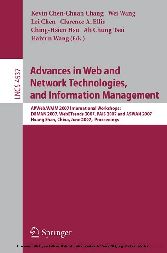Search and Find
Service
More of the content

Advances in Web and Network Technologies, and Information Management - APWeb/WAIM 2007 International Workshops
Investigative Queries in Sensor Networks (p. 133)
1 Introduction
Sensor network applications have brought a phenomenal change in how this world views Information Technology as a field of science. In the event of taking ‘computing’ from labs’ desks to farms & roads, computer science has made huge sacrifices to cope up with energy constraints in the new little computing machines. The leap is huge, the paradigm shift to real world is brilliant but in the process we have lost much of what we used to call the power of computing.
Low power, low communication range, micro storage, tiny processor, tiny operating system and tiny database are the typical characteristics of today’s sensor node in a typical sensor network. Sensor networks have thus taken us on a beautiful journey on a time machine, few decades backwards in terms of computing. The same old problems of memory management, communication, computations on a low capability processor and many more such classical problems have been revisited in the recent sensor network literature.
On the other side, emergence of sensor networks in new domains has excited some fresh applications and new problems to the research community. They actually have injected fresh blood into the veins of distributed computing. Distributed data management and query processing were enlivened by the advent of these distributed sensors. The sensor network research community has two major views of sensor networks. One half of the community views sensor nodes as tiny computers networked together in a huge space.
Another half views the tiny sensors as small relational tables and the entire network as an active database. A huge portion of research is devoted to processing of sensor network queries. This paper observes a rise of a new class of queries in sensor networks owing to the demand of some new applications. We call them investigative queries. Investigative queries are active recursive queries that probe into a network seeking some application data. They are executed in hierarchical fashion. The data collected by one level of this query will decide on the execution of the next level of the same query.
This paper aims at defining investigative queries after classifying the list of queries available in sensor network literature. Dissemination of investigative queries into the network requires some special communication architecture to provide the hierarchy levels needed for the application. The requirements are discussed in detail. We provide a strong motivating application to demonstrate the need of investigative queries.
The paper is organised into five major sections. Section 2 aims at classifying the sensor network query routing protocols and provides different types of queries that exists in sensor network literature. In section 3 a sensor network application is described in detail where a new type of query called the investigative query is introduced. Formal definition of investigative queries is provided in section 4, which is the main contribution of this paper. The advantages of investigative queries over traditional methods are discussed along with other potential applications of sensor networks in the same section.
2 Classification of Queries in Sensor Networks
In this section we classify query processing in sensor networks in terms of their communication architecture and then by the data processing methodology. Query processing in sensor networks can be broadly classified based on their query dissemination and data gathering approaches into four major classes,
• Data Flooding
• Tree Path routing
• Multi Path routing
• Clustered routing
All prices incl. VAT












